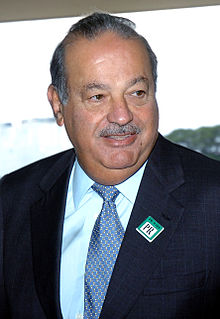Carlos Slim sponsorced ” Anonymus ” witness project by Alex Ross.
“In Mexico, where tens of thousands of people have been killed in recent drug wars, a technical delegation (or “techdel”) organized by the State Department in 2009 came up with the idea of overcoming the fear of reprisals for reporting crime by creating a mechanism for making anonymous, free tip-offs by mobile phone. The world’s richest man, Mexican entrepreneur Carlos Slim, agreed to sponsor the project. ”
| Carlos Slim | |
|---|---|

Carlos Slim, Chairman of Grupo Carso, arriving in the Presidential Palace for a meeting with Brazil’s President Luiz Inácio Lula da Silva on October 24, 2007
|
|
| Born | Carlos Slim Helú January 28, 1940 Mexico City, Mexico |
| Residence | Mexico City, Mexico |
| Nationality | Mexican |
| Ethnicity | Lebanese |
| Education | Civil Engineering |
| Alma mater | Universidad Nacional Autónoma de México |
| Occupation | Chairman & CEO of Telmex, América Móvil and Grupo Carso |
| Known for | World’s wealthiest person (2007, 2010-2013) |
| Net worth | |
| Religion | Maronite Catholicism[2] |
| Spouse(s) | Soumaya Domit (m. 1967; wid. 1999) |
| Children | Carlos Marco Antonio Patrick Soumaya Vanessa Johanna |
| Parents | Julián Slim Haddad (deceased) Linda Helú |
Carlos Slim Helú (Spanish pronunciation: [ˈkaɾlos esˈlin eˈlu]; born January 28, 1940) is a Mexican business magnate, investor, and philanthropist. From 2010 to 2013, Slim was ranked as the richest person in the world,[3] but that position has been regained by Bill Gates.[4] His extensive holdings in a considerable number of Mexican companies through his conglomerate, Grupo Carso, SA de CV, have amassed interests in the fields of communications, media, technology, retailing, and finance. Presently, Slim is the chairman and chief executive of telecommunications companies Telmex and América Móvil.
América Móvil, which was Latin America’s largest mobile-phone carrier in 2010, accounted for around US$49 billion of Slim’s wealth by the end of that year.[5] His corporate holdings as of December 2013 have been estimated at US$71.2 billion.[1]
Contents
Early life
Slim was born in Mexico City, Mexico in 1940 to Maronite Catholic parents, Julián Slim Haddad and Linda Helú, both of Lebanese descent.[6][7] His father, born Khalil Salim Haddad Aglamaz, emigrated to Mexico from Lebanon (then part of the Ottoman Empire) at the age of 14 in 1902 and changed his name to Julián Slim Haddad.[6] It was not uncommon for Lebanese children to be sent abroad before they reached the age of 15 to avoid being conscripted into the Ottoman army; four of Haddad’s older brothers were already living in Mexico at the time of his arrival.[8]
Carlos Slim’s mother, Linda Helú Atta, was born in Parral, Chihuahua, of Lebanese parents who had immigrated to Mexico in the late 19th century. Her parents upon immigrating to Mexico had founded one of the first Arabic language magazines for the Lebanese-Mexican community, using a printing press they had brought with them.[8]
In 1911, Julián established a dry goods store, La Estrella del Oriente (The Star of the Orient). By 1921, he had purchased real estate in the flourishing commercial district of Mexico City. These enterprises became the source of considerable wealth.[8]
In August 1926, Julián Slim and Linda Helú married. They had six children: Nour, Alma, Julián, José, Carlos and Linda. Julián senior died in 1953.[8]
Business career
Slim and his siblings were taught basic business practices by their father, and at the age of 12, Slim bought shares in a Mexican bank. At the age of 17, he earned 200 pesos a week working for his father’s company.[9] He went on to study civil engineering at the National Autonomous University of Mexico, where he also concurrently taught algebra and linear programming.[8] After graduating from college, Slim began his career as a trader in Mexico to hone his business skills. He would then go on to form his own brokerage firm that later expanded to invest in individual businesses, ranging from construction and manufacturing to retail and restaurants. In 1965, he incorporated Inversora Bursátil and bought Jarritos del Sur. In 1966, already worth US$40 million,[10] he founded Inmobiliaria Carso. Three months later, he married Soumaya Domit Gemayel (the Carso name derives from the first three letters of Carlos and the first two of Soumaya), and they remained married until her death in 1999.[8]
Companies found within the construction, real estate, and mining industries were the focus of Slim’s early career. By 1972, he had established or acquired a further seven businesses in these categories, including one which rented construction equipment. In 1976, he branched out by buying a 60% interest in a printing business, and in 1980, he consolidated his business interests by forming Grupo Galas as the parent company of a conglomerate that had interests in industry, construction, mining, retail, food, and tobacco.[8]
In 1982, the Mexican economy, which had substantially relied on oil exports, contracted rapidly as the price of oil fell and interest rates rose worldwide. Banks and other businesses were nationalized, crippled, or collapsed, and the peso was devalued.[citation needed] At this time, and during the period of recovery to 1985, Slim invested heavily. He bought all or a large percentage of numerous Mexican businesses, including Reynolds Aluminio, General Popo (General Tire‘s trading name in Mexico), Bimex hotels, and the Sanborns food retailer. He also acquired a 40% and 50% interest in the Mexican arms of British American Tobacco and The Hershey Company, respectively. He moved into financial services as well, buying Seguros de México and creating from it, along with other purchases such as Fianzas La Guardiana and Casa de Bolsa Inbursa, the Grupo Financiero Inbursa. Many of these acquisitions were financed by the cash flows from Cigatam, a tobacco business which he bought early in the economic downturn.[8]
In 1988 Slim added the Nacrobre group of companies – which trade in copper and aluminium products – along with a chemicals business, Química Fluor, and others.[8]
In 1990, the Grupo Carso was floated as a public company initially in Mexico and then worldwide.[8]
Later in 1990, Slim acted in concert with France Télécom and Southwestern Bell Corporation in order to buy the landline telephony company Telmex from the Mexican government.[8] By 2006, 90 percent of the telephone lines in Mexico were operated by Telmex, and his mobile telephony company, Telcel, which was created out of the Radiomóvil Dipsa company,[8] operated almost 80 percent of all the country’s cellphones.[11]
In 1991, he acquired Hoteles Calinda (now OSTAR Grupo Hotelero), and in 1993, he increased his stakes in General Tire and Grupo Aluminio to the point where he had a majority interest.[8]
In 1996, Grupo Carso was split into three companies: Carso Global Telecom, Grupo Carso, and Invercorporación. In the following year, Slim bought the Mexican arm of Sears Roebuck.[8]
1999 saw Slim expanding his business interests beyond Latin America; he set up Telmex USA and also acquired a stake in Tracfone, a US cellular telephone company. At the same time, he established Carso Infraestructura y Construcción, S. A. (CICSA) as a construction and engineering company within Grupo Carso.[8] In 1999 Slim had heart surgery and subsequently passed on much of the day-to-day involvement in the businesses to his children and their spouses.[11]
América Telecom, the holding company for América Móvil, was incorporated in 2000. It took stakes in various cellular telephone companies outside of Mexico, including the Brazilian ATL and Telecom Americas concerns, Techtel in Argentina, and others in Guatemala and Ecuador. In subsequent years, there was further investment in Latinamerica, with companies in Colombia, Nicaragua, Peru, Chile, Honduras, and El Salvador. 2000 also saw a venture with Microsoft which led to the start of the Spanish T1msn portal, later renamed ProdigyMSN.[8]
In 2005, Slim invested in the Volaris airline[8] and formed Impulsora del Desarrollo y el Empleo en America Latina SAB de CV (using the acronym “IDEAL”—roughly translated as “Promoter of Development and Employment in Latin America”), a Mexico-based company primarily engaged in not-for-profit infrastructure development.
In 2007 after having amassed a 50.1% stake in the Cigatam tobacco company, Slim reduced his holdings by selling a large portion to Philip Morris for $1.1bn, while in the same year also selling his entire interest in a tile company, Porcelanite, for $800m. He licensed the Saks name and opened Saks Fifth Avenue in Santa Fe, Mexico. In 2008 he took a 6.4% stake in The New York Times Company,[8] which increased to 8% by 2012.[12]
On December 8, 2007, Grupo Carso announced that the remaining 103 CompUSA stores would be either liquidated or sold, bringing an end to the struggling company,[13] although the IT tech part of CompUSA continued under the name Telvista with U.S. locations in Dallas, Texas (U.S. Corporate Office) and Danville, Virginia. Telvista has five centers in Mexico (three in Tijuana, one center in Mexicali, and one in México City).[14] After 28 years, Slim became the Honorary Lifetime Chairman of the business. He is also Chairman of Teléfonos de Mexico, América Móvil, and Grupo Financiero Inbursa.
Slim built Plaza Carso in Mexico City, where most of his ventures share a common headquarters address.[15]
In March 2012, Slim along with American television host Larry King established Ora TV, an on-demand digital television network that produces and distributes television shows including Larry King Now, Politicking with Larry King, Recessionista, and Jesse Ventura Uncensored. The network was used as an outlet to produce a new show for Larry King after leaving CNN.[16]
On April 23, 2014 Slim took control of Telekom Austria established in seven central and Eastern European countries outside Austria, under a 10 year agreement, being his first successful acquisition in Europe. In a syndicate holding structure the Austrian state holding company OIAG’s 28 percent are combined with Slim’s 27 percent ownership. America Movil will spend as much as $2 billion to buy out minority shareholders in a mandatory public offer and invest up to 1 billion euros ($1.38 billion) into the company, which it sees as “platform for expansion into central and eastern Europe”. Labor representatives boykotted attending the OIAG supervisory board meeting for 12 h criticizing lack of explicit job guarantees.[17]
Personal life
Slim was married to Soumaya Domit from 1967 until her death in 1999. Among her interests were various philanthropic projects, including the creation of a legal framework for organ donation.[8] Slim has six children: Carlos, Marco Antonio, Patrick, Soumaya, Vanessa, and Johanna.[18] Slim underwent heart surgery in 1999.[11]
Personal fortune
Wealth
On March 29, 2007, Slim surpassed Warren Buffett as the world’s second richest person with an estimated net worth of $53.1 billion compared to Buffet’s $52.4 billion.[19]
On August 4, 2007, The Wall Street Journal ran a cover story profiling Slim. The article said, “While the market value of his stake in publicly traded companies could decline at any time, at the moment he is probably wealthier than Bill Gates“.[20] According to The Wall Street Journal, Slim credits part of his ability to “discover investment opportunities” early to the writings of his friend, futurist author Alvin Toffler.[20]
On August 8, 2007, Fortune reported that Slim had overtaken Gates as the world’s richest person. Slim’s estimated fortune soared to $59 billion, based on the value of his public holdings at the end of July. Gates’ net worth was estimated to be at least $58 billion.[20][21]
On March 5, 2008, Forbes ranked Slim as the world’s second-richest person, behind Warren Buffett and ahead of Bill Gates.[22]
On March 11, 2009, Forbes ranked Slim as the world’s third-richest person, behind Gates and Buffett and ahead of Larry Ellison.[22]
On March 10, 2010, Forbes once again reported that Slim had overtaken Gates as the world’s richest person, with a net worth of $53.5 billion. At the time, Gates and Buffett had a net worth of $53 billion and $47 billion respectively.[22] He was the first Mexican to top the list.[23] It was the first time in 16 years that the person on top of the list was not from the United States.[24] It was also the first time the person at the top of the list was from an “emerging economy.”[25]
In March 2011, Forbes stated that Slim had maintained his position as the wealthiest person in the world, with his fortune estimated at $74 billion.[3]
In December 2012, according to the Bloomberg Billionaires Index, Carlos Slim Helú remains the world’s richest person with an estimated net worth of $75.5 billion.[26]
On March 5, 2013, Forbes stated that Slim is still maintaining his first place position as the wealthiest person on the globe, with an estimated net worth of US$73 billion.[27]
On May 16, 2013, Bloomberg L.P. ranked Slim the second richest person in the world, after Bill Gates.[28]
Personal assets
Slim owns the Duke Seamans mansion, a 1901 Beaux arts house on 5th Avenue in New York City, which he bought for $44 million in 2010. The mansion is 20,000 sqft large and has 12 bedrooms, 14 bathrooms, a doctor’s office in the basement.[29]
Philanthropy
Slim founded three non-profit foundations concentrating on Mexico City: one for the arts, education and health care, one for sports and one for downtown restoration.
- Fundación Carlos Slim Helú
Established in 1986 Fundación Carlos Slim Helú sponsors the Museo Soumaya in Mexico City, named after Slim’s late wife, Soumaya Domit, opened 2011. It holds 66,000 pieces, including religious relics, contains the world’s second-largest collection of Rodin sculptures, including The Kiss, the largest Dalí collection in Latin America, works by Leonardo da Vinci, Pablo Picasso, Pierre-Auguste Renoir, and coins from the viceroys of Spain.[30] The inauguration in 2011 was attended by the President of Mexico, Nobel Prize laureates, writers and other celebrities.[31]
After stating that he had donated $4 billion of dividends to Fundación Carlos Slim Helú, $2 billion in 2006 and another $2 billion in 2010, Slim was ranked fifth in Forbes‘ World’s Biggest Givers in May 2011.[32] Education and health care projects have included $100 million to perform 50,000 cataract surgeries in Peru through the Clinton Initiative, a $20 million fund to strengthen small and medium-size businesses in Colombia, and a digital education program for youth in Mexico, $150 million for programs in nutrition and disease prevention in Central America with the Bill & Melinda Gates Foundation and the government of Spain, $50 million to work with the World Wildlife Fund on restoration of six areas for species in Mexico, including the monarch butterfly and $100 million on education programs for young people through Colombian singer Shakira’s Alas Foundation.[32]
- Fundación Telmex
In 1995 Slim established Fundación Telmex, a broad-ranging philanthropic foundation, which as he announced in 2007 had been provided with an asset base of $4 billion to establish Carso Institutes for Health, Sports and Education. Furthermore, it was to work in support of an initiative of Bill Clinton to aid the people of Latin America.[8] Because Mexican foundations are not required to publish their financial information, it is not possible to confirm Slim’s claims of charitable giving through a public source.[32] The foundation has organized Copa Telmex, an amateur sports tournament, recognized in 2007 and 2008 by Guinness World Records as having the most participants of any such tournament in the world. Together with Fundación Carlos Slim Helú, Telmex announced in 2008 that it was to invest more than $250 million in Mexican sports programs, from grass-roots level to Olympic standard.[8] Telmex sponsored the Sauber F1 team for the 2011 season.[33] [34] [35]
- Fundación del Centro Histórico de la Ciudad de México A.C.
In 2000, Slim and ex-broadcaster Jacobo Zabludowsky organized the Fundación del Centro Histórico de la Ciudad de México A.C. (Mexico City Historic Downtown Foundation),to revitalize and rescue Mexico City’s historic downtown area to enable more people to live, work and find entertainment there.[8] He has been Chairman of the Council for the Restoration of the Historic Downtown of Mexico City since 2001.[36] In 2011 he, along with the President of Mexico, Mexico City Mayor and Mexico City Archbishop, inaugurated the first phase of Plaza Mariana close to Basilica de Guadalupe.[37] The complex, whose construction was funded by Slim, includes an evangelization center, museum, columbarium, health center, and market.[38]
Achievements
Slim has been vice-president of the Mexican Stock Exchange and president of the Mexican Association of Brokerage Houses.[when?] He was the first president of the Latin-American Committee of the New York Stock Exchange Administration Council, and was in office from 1996 through 1998.
Slim was on the Board of Directors of the Altria Group (previously known as Philip Morris) until his resignation in April 2006. Slim was also on the Board of Directors of Alcatel. Slim currently sits on the Board of Directors for Philip Morris International. He was on the Board of Directors of SBC Communications until July 2004, when he quit to devote more time to the World Education & Development Fund, which is focused on infrastructure, health and education projects. In 1997, just before the company introduced its iMac line, Slim bought 3% of Apple Inc.‘s stock.
In 2008 it was reported that Slim had shown an interest in buying the Honda Formula One team.[39]
Awards
- Entrepreneurial Merit Medal of Honor in 1985 from Mexico’s Chamber of Commerce.
- “Gold Patron” of the American Academy of Achievement,[40]
- Commander in the Belgian Order of Leopold II
- CEO of the year in 2003 by Latin Trade magazine
- CEO of the decade in 2004 by Latin Trade magazine
- Fundacion Telmex received in 2007 the National Sports Prize of Mexico for sports promotion
- In 2008 his philanthropy was recognised with the award of The National Order of the Cedar by the Lebanese government.[8]
- In 2011 the Hispanic Society of America awarded Fundacion Carlos Slim the Sorolla Medal for its contribution to the arts and culture[41]
- On May 20, 2012 Slim was awarded a Honorary Doctorate in Public Service from George Washington University.[42]
Criticism
The Mexican magnate’s growing fortune has caused controversy, because it has been amassed in a developing country where average per capita income does not surpass $14,500 a year, and nearly 17% of the population lives in poverty.[43] Critics claim that Slim is a monopolist, pointing to Telmex’s control of 90% of the Mexican landline telephone market. Slim’s wealth is the equivalent of roughly 5% of Mexico’s annual economic output.[32] Telmex, of which 49.1% is owned by Slim and his family, charges among the highest usage fees in the world, according to the Organisation for Economic Co-operation and Development.[44]
According to Celso Garrido, economist at the Universidad Nacional Autónoma de México, Slim’s domination of Mexico’s conglomerates prevents the growth of smaller companies, resulting in a shortage of paying jobs, forcing many Mexicans to seek better lives in the US.[45]
Slim has stated, “When you live for others’ opinions, you are dead. I don’t want to live thinking about how I’ll be remembered” by Mexican people claiming indifference about his position on Forbes list of the world’s richest people. He has said he has no interest in becoming the world’s richest person. When asked to explain his sudden increase in wealth at a press conference soon after Forbes annual rankings were published, he said, “The stock market goes up … and down”, and noted that his fortune could quickly drop.[32]
Slim has been publicly skeptical of The Giving Pledge by Bill Gates and Warren Buffett giving away at least half of their fortunes, but has of 2011 devoted $4 billion, or roughly 5%, to his Carlos Slim foundation.[32]
Slim was criticized by Dutch Minister of Economic Affairs, Henk Kamp in 2013 for attempting to expand his telecom empire beyond the Americas by América Móvil‘s buy-out offer to KPN, a Dutch landline and mobile telecommunications company privatized in the 90′s, by stating “an acquisition of KPN by a “foreign company” could have consequences for the Netherland’s national security”.[46]
See also
References
- “Forbes list of Billionaires”. Retrieved December 6, 2013.
- Allentuck, Andrew (March 2009). “Carlos Slim Helu”. Trade by Numbers (globeinvestor.com). Retrieved May 26, 2012.
- “Carlos Slim Helu & family”. Forbes. Retrieved March 5, 2013.
- Berman, Jillian (May 16, 2013). “Bill Gates Surpasses Carlos Slim To Become Richest Man In The World”. Huffington Post.
- Harrison, Crayton (February 10, 2011). “Carlos Slim Sees Colombia Rising as Commodity Choice”. Bloomberg. Retrieved February 19, 2011.
- Bone, James (March 11, 2010). “Mexican mogul Carlos Slim got his big break in sell-off of national telephone firm”. The Times (London). Retrieved June 17, 2011.
- Padgett, Tim (July 11, 2007). “Carlos Slim’s Embarrassment of Riches”. Time Magazine (United States). Retrieved June 17, 2011.
- “Biography”. Carlos Slim Helú. Retrieved February 19, 2011.[unreliable source?]
- Dolan, Kerry (March 26, 2012). “The World According To Slim”. Forbes – Billionaires 2012. Retrieved March 8, 2012.
- “Profile: Carlos Slim”. BBC News. March 10, 2010. Retrieved April 28, 2010.
- Thompson, Ginger (June 3, 2006). “Prodded by the Left, Mexico’s Richest Man Talks Equity”. New York Times.
- Schumpeter: The global Mexican. The Economist (2012-10-27). Retrieved on 2013-07-14.
- “End of the Line for CompUSA”. San Francisco Chronicle. December 9, 2007. Retrieved December 9, 2007.
- Telvista – Call Center Locations
- “Slim Spending $1.4 Billion on Complex in Mexico City”. Latin American Herald Tribune. 2011. Retrieved 24 April 2014.
- Carlson, Erin (3/12/2012). “Larry King to Launch Interview Show on Ora.tv”. Hollywood Reporter. Retrieved 16 December 2013.
- Georgina Prodhan; Angelika Gruber (24 April 2014). “Slim seeks to build Telekom Austria into European player”. Reuters. Retrieved 24 April 2014. “”There came a point where we felt there was just not very much more to be done in terms of expansion in the Americas,” Garcia Moreno told a news conference in Vienna”
- Alexander, Harriet (February 19, 2011). “Carlos Slim: At home with the world’s richest man”. Telegraph.co.uk (London: Telegraph Media Group). Retrieved May 8, 2013.
- Coster, Helen (April 11, 2007). “Carlos Slim Helu Now World’s Second-Richest Man”. Forbes. Archived from the original on September 28, 2008. Retrieved August 11, 2007.
- Luhnow, David (August 4, 2007). “The Secrets of the World’s Richest Man”. The Wall Street Journal. p. A1. Retrieved August 4, 2007.
- Mehta, Stephanie (August 6, 2007). “Carlos Slim, the richest man in the world”. Fortune. Retrieved August 6, 2007.
- “Carlos Slim Helu”. Forbes. March 10, 2010. Retrieved February 20, 2011.
- “Mexican overtakes Bill Gates as world’s wealthiest man”. Bild. March 11, 2010. Retrieved March 11, 2010.
- “Rich list signals shift in fortunes”. Al Jazeera. March 11, 2010. Retrieved March 11, 2010.
- “Year’s richest man, first from emerging economy, bumps Gates”. Deutsche Welle. March 11, 2010. Retrieved March 11, 2010.
- “Bloomberg Billionaires Index”. Bloomberg LP. Retrieved December 14, 2012.
- “Forbes Carlos Slim Helu & family”. Forbes. Retrieved March 5, 2013.
- “Bill Gates Retakes World’s Richest Title From Carlos Slim”, by Alex Cuadros and Crayton Harrison, Bloomberg L.P. online at Yahoo! Finance, retrieved May 16, 2013.
- Andrea Divirgilio (August 5, 2011). “The real estate trend with billionaires is investing in US property market”. Born Rich.com.
- Casey, Nicholas (March 3, 2011). “Emperor’s New Museum”. Wall Street Journal. Retrieved March 8, 2012.
- Template:Ciyte news
- Kerry A. Dolan (2 May 2011). “Mexico’s Carlos Slim Joins Ranks Of World’s Biggest Philanthropists”. Forbes. Retrieved June 3, 2011.
- “F1: Sauber Signs Perez, Sponsor Telmex For 2011”. speedtv.com. October 4, 2010. Retrieved May 10, 2011.
- Baldwin, Alan (October 4, 2010). “Motor racing-Mexico’s Perez to race for Sauber”. Reuters. Retrieved May 10, 2011.
- “Sauber snap up hot Mexican prospect Sergio Perez for 2011 Formula 1 season”. Daily Mail (London). October 7, 2010. Retrieved May 10, 2011.
- Mexico City Historic Downtown Foundation (Spanish)
- Inauguration of Plaza Mariana
- Description of Plaza Mariana (Spanish)
- “Carlos Slim Eyes Honda Purchase”. speedtv.com. December 22, 2008. Retrieved December 22, 2008.
- “About the Academy: Academy Patrons”. Academy of Achievement website. Academy of Achievement. 2007. Retrieved August 6, 2007.
- The Hispanic Society of America award
- Honorary Doctorate in Public Service by George Washington University
- “UN HDI table”. United Nations. 2008. Retrieved May 27, 2009.
- Smith, Geri (March 5, 2007). “Slim’s Big Giveaway: As the government steps up its scrutiny, the billionaire is stepping up his philanthropy”. BusinessWeek. Retrieved May 27, 2009.
- Porras, Andy (13 July 13, 2007). “Mexico’s wealthiest mogul spurs controversy”. Hispanic Link. Retrieved May 27, 2009.
- Dolia Estevez (13 September 2013). “Dutch Government Issues Warning On Takeover Of Telecom Firm KPN By Mexican Billionaire Carlos Slim”. Retrieved 24 April 2014.
External links
| Wikimedia Commons has media related to Carlos Slim. |
| Wikiquote has a collection of quotations related to: Carlos Slim Helú |
- Official website
- Profile at Forbes
- Appearances on C-SPAN
- Carlos Slim collected news and commentary at The Guardian
- Carlos Slim collected news and commentary at The New York Times
- Carlos Slim collected news and commentary at The Wall Street Journal
- Carlos Slim at the Notable Names Database
- “From the Richest man in the World”.











